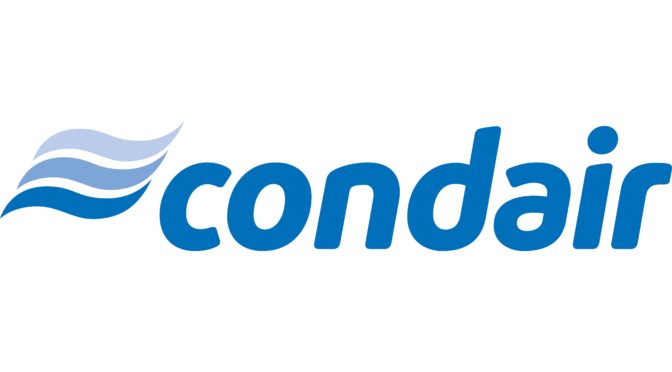Monthly Archives: January 2017
New product innovations from Ancon at Ecobuild 2017
Story
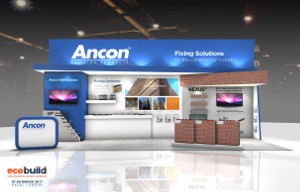
Keeping innovation at the top of its agenda, high integrity structural fixings manufacturer, Ancon, will further expand its wide product range with new product launches at the UK’s largest event for specifiers in the built environment, Ecobuild 2017.
With four key product zones, the Ancon stand B135, will feature the innovative Nexus brick-faced support system for prefabricated soffits, structural thermal breaks for balcony locations, KSN Anchors for quicker, safer reinforcement continuity at construction joints and a comprehensive range of low thermal conductivity wall ties.
Nexus Brick Soffit Support Systems
Creating architectural brick features including soffits, deep reveals and flying beams has never been easier thanks to the lightweight, brick-faced Nexus® system developed by Ancon and cut-brick specialist Ibstock Kevington.
Combining a specially developed brick faced steel unit with Ancon’s tried and tested MDC stainless steel bracket angle support system, Nexus is quick to install as no mechanical lifting is required, is lighter and easier to handle than precast concrete soffit systems and its two-part design allows full adjustment on site resulting in perfect alignment.
Insulated Balcony Connectors
To help designers meet their thermal performance aspirations, Ancon has once again expanded its range of structural thermal breaks for balcony locations to accommodate even higher loads. Typical applications for these high performance products include large cantilever balconies and situations where column layout or rebar congestion limits the number of connectors that can be installed.
Minimising heat loss while maintaining structural integrity, Ancon balcony connectors are available to suit concrete-to-concrete, steel-to-concrete and steel-to-steel applications. All solutions can also now be specified in stainless steel which is 3x more thermally efficient than galvanised/carbon steel.
KSN Anchor Reinforcement Continuity Systems
The award-winning CARES-approved KSN Anchor system allows engineers to design slab-to-wall connections in reinforced concrete frames without the restrictions on bar length and bar diameter of traditional re-bend continuity systems.
The system works by casting internally threaded anchors into a concrete wall which accept Bartec parallel thread reinforcing bars during construction of the adjoining slab. A new Ancon video demonstrates how KSN Anchors accelerate construction and improve on site working conditions by eliminating the dangers inherent with projecting starter bars and bar straightening required by rebend continuity boxes.
Low Thermal Conductivity Wall Ties
For visitors designing PassivHaus and Zero Carbon projects, a new product innovation from the award-winning Teplo range of basalt fibre wall ties will be unveiled at the show. Samples of Ancon’s low thermal conductivity ties will be displayed including the new Teplo-BF, a new build cavity wall tie with a thermal conductivity of just 0.7W/mK that has exceptional mortar grabbing capability, suitable for use with lime and other slow-drying mortars.
The Ancon stand gives visitors an excellent opportunity to talk one on one with our experienced technical and sales support team who will be happy to help with specific project or business requirements. Contact Ancon on 0114 275 5224, email info@ancon.co.uk or visit www.ancon.co.uk.
View Ancon's profile:
Evaporative cooling app from Condair
Story

Condair, formerly JS Humidifiers, has developed a new app that accurately determines how much energy could be saved by using in-duct exhaust air evaporative cooling and a heat recovery system, rather than just traditional compressor driven cooling.
Using worldwide weather data from Meteonorm, the myCoolblue app calculates how much energy is needed annually to cool a building. Then, taking into account 10 years of historic weather data from over 300 regions worldwide, the app projects how much cooling each month could be delivered using exhaust air evaporative cooling and how much would still need to be delivered using traditional mechanical cooling.
Exhaust air evaporative cooling uses an adiabatic humidifier to cool the return air from a room and a heat recovery unit to transfer the cool thermal energy to the incoming fresh air stream. The technique can provide several degrees of cooling from just a few kilowatts of electricity, reducing a building’s energy bills and carbon footprint.
By assessing how much of a building’s cooling can be delivered with exhaust air cooling, a HVAC consultant or AHU designer can accurately calculate the viability of an in-duct evaporative cooling system and show its return on investment potential.
For instance, Condair’s myCoolblue app shows that for a building in London needing to maintain an internal condition of 23°C during normal office hours, with 2m x 2m AHU and airflow of 2.6m³/s, the typical annual cooling load would be 33,532kWh. Given the 10-year historic weather conditions for London, myCoolblue app shows that, in an average year, an exhaust air evaporative cooling system could deliver 53% of the required cooling.
The app gives energy projections for hot or average summer conditions and takes into account a comprehensive set of variables to provide an accurate calculation for any project. These variables include the type and efficiency of the heat recovery unit being employed, the location of the fans and the humidifier
configuration inside the AHU, alongside the actual design conditions and operating parameters of the AHU itself.
A chart showing the monthly breakdown in kWh between mechanical and evaporative cooling is presented, along with a diagram of the system configuration and the temperature course supply/exhaust chart. Project details and calculations can be saved to the cloud and accessed later. An email option also allows reports with all the project parameters to be emailed in a pdf format for future reference.
Condair’s myCoolblue app can be downloaded from the App Store for free and is available for iPad only.
Condair Group is the world’s leading specialist in humidification and evaporative cooling, with energy efficient, hygienic and innovative technologies for commercial, industrial and heritage applications. Condair is represented in the UK by Condair plc, which offers system design, manufacture, supply, installation, commissioning, maintenance and spares. Condair plc is the new name for JS Humidifiers following the organisation’s rebranding in October 2014. You can find out more by visiting the company’s website at www.condair.co.uk.
View Condair's profile:
Klober membranes in Grand Designs project
Story

Klober membranes have been used in a couple’s zero carbon eco-home which featured in the latest series of Grand Designs. The five-bedroom, 4,300sq ft timber frame building on the West Pennine moor has Wallint 50 on the warm side of the insulation to provide an air barrier and vapour control layer. By contrast, Permo forte was installed on the cold side of the insulation to enable moisture within the building to escape and provide a weatherproof barrier behind the timber cladding. Its vapour resistance value of 0.15 MN/sg is well below the 0.6 MN/sg requirement for walls.
View Klober's profile:
Triton extends liquid applied waterproofing range
Story
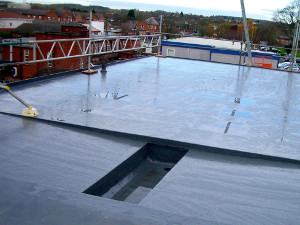
Triton has extended its range of liquid applied waterproofing products to offer a wider choice of systems primarily for the reliable waterproofing of roofs and podium decks. Each of the three new systems provides Type A barrier protection waterproofing as defined in BS 8102 (2009). They are quick and easy to apply, very fast curing and suitable for application in cooler temperatures – therefore extending the season for application and reducing the downtime of areas treated.
TWS-Poly H produces a totally seamless waterproof surface on prepared concrete and can be applied by squeegee, brush, trowel or roller. The 2-component polyurea formulation is ideal for waterproofing pitched or flat roofs, decks and balconies and other areas where a degree of flexibility is required. The trafficable, cured surface also makes it suitable for waterproofing concrete floors in car parks etc. TWS-Poly H can also be applied to internal and external walls.
TWS-Poly S is another fast curing, 2-component polyuria formulation but designed for application by a twin nozzle, heated spray unit. Offering excellent bonding strength and crack bridging capability, TWS-Poly S can be combined with geotextiles to obtain on-site applied, seamless liners or coatings in tunnels or canals or used to waterproof pitched or flat roofs. The cured surface allows for building movement and is trafficable and highly resistant to abrasion.
Single component TWS Fastcoat cures as an elastic and seamless layer that offers excellent weather resistance and can withstand permanent water contact. A key feature is its ability to deliver a combination of root barrier and waterproofing layer, therefore reducing the number of layers required in green roof construction. Applied by brush, spreader or airless equipment, its cured surface can be lightly trafficked making it suitable for low pitch or flat roofs and balconies.
Liquid applied waterproofing systems can deal with complex shapes and contours where joints or folds in other waterproofing materials might cause a weakness. Technical support on the specification and installation of all Triton’s waterproofing systems is available from Triton’s technical team. Installation guidelines and data sheets are also available for download at tritonsystems.co.uk
View Triton Systems's profile:
40 Micronics heat meters used in important Government building
Story
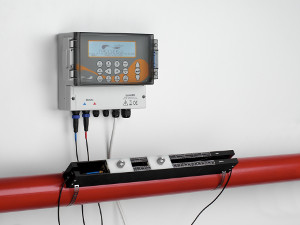
It is increasingly important in the current climate of public sector budget cuts that public buildings are as energy efficient as possible. In addition the Government wants to be at the forefront of the reduction in carbon in public buildings. One such building is the Foreign and Commonwealth Office which occupies a Victorian, Grade 1 listed building in St. James Place, London and has great historical value. A recent upgrade project at the FCO required the energy monitoring of approximately forty combined heating & cooling circuits in order to calculate and benchmark savings which could be made. The quest for energy and utility efficiency requires the best and most reliable measurement systems and Bridge Controls Ltd from Reading, Berkshire, the nominated BMS specialist on this project, had experience of the Micronics range of heat meters from past projects and specified the U3000 range of ultrasonic flow meters for this project. Bridge Controls undertook the installation of the flow meters and CF51 energy calculators which provide direct communication to the Trend BMS network and energy manager software suite.
Martin Knowles, Bridge Control’s Contracts Manager specified the U3000, a transit time ultrasonic flow meter and the CF51 Heating & Cooling Calculator as ideal for the job. Consequently, 40 U3000s were installed in the heating and cooling circuits throughout the building. The U3000 is designed to work with clamp on transducers and accurately measures liquid flowing through a closed pipe. It eliminates the need for any mechanical parts to be inserted through the pipe wall or to protrude into the flow system and because it takes just a few minutes to install, there is no need to shut down flow or drain the system. The CF51’s multifunctional display means that it is easy to read, providing rapid and clear access to important billing data.
Officials at the Foreign and Commonwealth Office were pleased with the installation which proceeded rapidly with no interruption to the day to day functioning of the office. They would certainly use Micronics heat meters in other Government buildings.
For further information on this project or the Micronics range call Micronics on +44(0)1628 810456, or visit www.micronicsflowmeters.com.
View Micronics's profile:
Triton’s Fastcoat delivers fast track elastomeric waterproofing.
Story
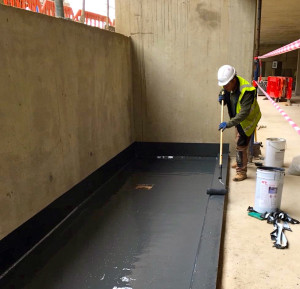
Triton’s elastomeric, liquid applied TWS-Fastcoat, has provided a rapid drying waterproofing solution for the floor slabs of the subterranean light wells at the Material Store housing development in Hayes.
The material Store development is part of the £250 million regeneration of The Old Vinyl Factory in Hayes, West London, where thousands of people worked for EMI, pressing and packaging vinyl records and making everything from radio sets to bicycles.
The slabs were constructed approximately 1.5m below ground level and although the new concrete incorporated a watertight concrete admixture would have remained gas and vapour permeable. Two coats of Triton’s TWS- Fastcoat, (which can be applied effectively in ambient temperatures even when substrate temperatures are as low as 0o), therefore provided an impervious barrier which will also lower the potential risks of corrosion of the steelwork in the slabs as well as protecting the outer surfaces.
TWS-Fastcoat is a single pack, moisture curing, elastomeric resin. The membrane cures in a continuous and elastic form, as a totally adhered layer. It guarantees total water tightness and withstands minor building movements and vibrations. TWS-Fastcoat can be used as a base coat, a reinforcing layer or a top-coat. Other typical applications include podium decks, low pitch and flat roof areas with pedestrian traffic, wet rooms, lightly trafficked flooring, water channels and ponds. In green roof applications, the addition of Triton’s geotextile fleece between the two coats of TWS-Fastcoat provides an effective root barrier and waterproofing layer.
At the Material Store development, as part of the preparation for the application of TWS-Fastcoat, Triton’s Fillet Seal was applied in 25mm beads to all internal angles that eliminates 90o angles at wall/floor transitions and minimises the risk of leaving gaps or holes unsealed. It was also important to ensure that the concrete surface was clean and dust free. On porous or friable surfaces, Triton’s TWS-PU Primer should be applied before the application of TWS-Fastcoat.
The slabs will receive raised access floors over the TWS-Fastcoat layer, allowing any potential water/rain ingress to enter the drainage systems of the individual dwellings beneath the raised floor.
View Triton Systems's profile:
Micronics Clamp-on Flow Meter monitors hot water usage in major London museum for a decade
Story
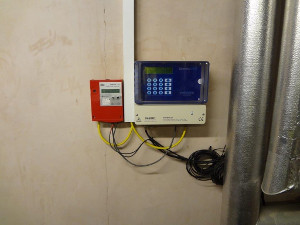
Imperial War Museums is a multi-branch national museum founded in 1917 to record the story of the Great War and the contributions made to it by the peoples of the Empire. IWM Duxford, a branch of IWM is Britain’s largest aviation museum. The site was originally designed as a Training Depot Station and construction started on 15 October 1917. The buildings have been adapted from their original use and in 2004 work to convert the Armoury into a Visitor Centre and Café was completed. The wet heating system for the café was integral to the Visitor Centre. The Facilities Management team at the site use a Micronics clamp-on ultrasonic flowmeter to monitor the energy use by the Café. The partner is charged for energy usage and Malcolm Price, the Facilities Manager was keen to establish the relative usage to ensure that the charges were apportioned accurately. The museum is committed to sustainability, reduced energy use and effectiveness and energy costs are a major part of the museum running costs, and measuring and monitoring use is a vital tool in achieving this. Malcolm Price saw the Micronics stand at an energy event and was impressed by the simple but seemingly reliable technology.
The Micronics flow meter was chosen because it offered a non-invasive, quick and reliable flow measurement solution. With its easy to follow menu and simple set up it proved to be a cost-effective alternative to a traditional in-line meter installation. No installation drain down or pipe cutting was required and in addition dry servicing is possible so that downtime is kept to a minimum, absolutely vital in a building which is open to the public throughout the year.
Malcolm Price has total confidence in the Micronics product born of many years of experience. “It is crucial to have the ability to monitor the flow in the site. The unit has worked extremely well for 10 years and is still producing the data we require. I would recommend it to anyone who wants to accurately establish the amount of energy being used. This is particularly important in public buildings like the IWM where there is a statutory requirement to be as efficient as possible.”
For further information on this project or the Micronics range call Micronics on +44(0)1628 810456, or visit www.micronicsflowmeters.com.
View Micronics's profile:
Recotherm are industry leaders in pool ventilation solutions
Story

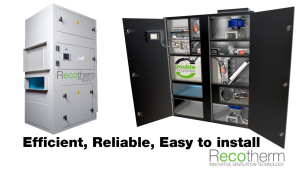
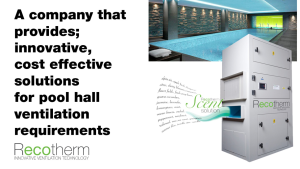

Recotherm is an established company that has built high quality climate control systems for indoor swimming pools since 1985.
Recotherm developed a unique concept in 1991, which was an industry milestone when launched. Previous experience with heat pumps showed that the technology was often under utilised and therefore expensive to run, so they set about a redesign that utilised the properties of ‘fresh air’.
This concept breakthrough set the tone for Recotherm products for the next 25 years.
Recotherm’s Martin Killen advised ‘Recotherm’s mission is simple, we want to engineer the best product for the job, for the best price, ensuring efficiency and running costs are at the forefront of our thinking and to develop new ideas whenever viable.’
Recotherm products offer several advantages, they offer
- Products built specifically for the swimming pool environment.
- Utilisation of ‘Fresh air’ for better climate control
- No use of harmful refrigerants
- Ultra Low running cost
- Reliability, and are ease of maintenance
- Simple installation with a flat pack solution for difficult sites, the systems need only to be connected to a heating circuit, low amperage electrical supply and return and supply ductwork and condensate drain
- Large screen monitor for easy operation
- Internal or external location
Why Recotherm use Fresh Air
Simply it replaces stale air with fresh warmed air, thus Chemical odours, stuffiness and condensation are removed.
With modern controls, efficient heat reclamation units and a modern custom designed ventilation strategy; Fresh air systems easily become more economical than refrigerant based dehumidifiers.
Recotherm are always innovating in their product features and can offer additional enhancements such as:
SCENT SOLUTION
This introduces fragrance into the air meaning that you can choose from a range of aromas making the pool hall smell like a spa experience
REMOTE MONITORING.
Recotherm units can be fitted with extra sensors and a SIM chip, to eliminate mis-diagnosis in the event of problems meaning wasted site visits are eliminated and a return to service speeded up.
Recotherm design and build their products in the UK and are available to consult with you and your technical advisors to engineer a perfect solution.
Please contact Recotherm for more information
Unit A Astwood bank Business Park, Astwood Lane, Astwood Bank, Redditch
Worcestershire B96 6HH
Tel 01527 894533
www.recotherm.co.uk
Email: sales@recotherm.co.uk

